
Phase I
The "Dân Thắng 21" Operations
From 20 to 26 October 1965
Lifting the Siege at Pleime
The Lure
When the VC began their attack against the Camp of Pleime, the Commanding General of II Corps and his tactical CP were in Binh Dinh to directly conduct the Than Phong 6 Operations. Immediately after the lifts of heliborne troops into suspect enemy concentrations south of the District of Hoai An, the Commanding General of II Corps got back to Pleiku in the afternoon 20 October 1965.
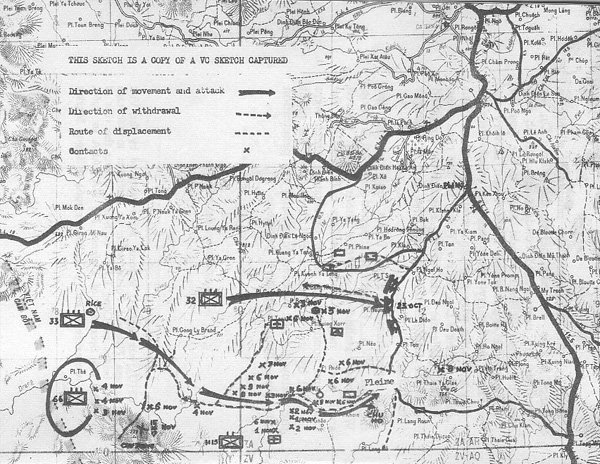
The violent enemy assault at dawn had been repelled and broken by timely and accurate airstrikes but air supply missions and medical evacuation by helicopter still encountered intense anti-aircraft fire. The VC although having suffered heavy casualties persisted to remain in the vicinity of the Camp and instead of one single battalion, their strength was rather of regimental size. In addition to the threat of an enemy superior in number, other difficulties assailed the garrison whose air supply of food and ammunition and evacuation of wounded was hindered by the incessant mortar shelling of the airstrip and the helipad.
It appeared that this time, the enemy did not hurry to act quickly as in previous "hit and run" attacks. It seemed that they rather planned to compel friendly forces to come in rescue and their objectives would be two fold, first the relief column and second, the Camp itself. This would give them a bigger prey and also more chance of success, thanks to a larger concentration of their forces.
II Corps Commander decided to play the enemy's game. Since the VC expected to
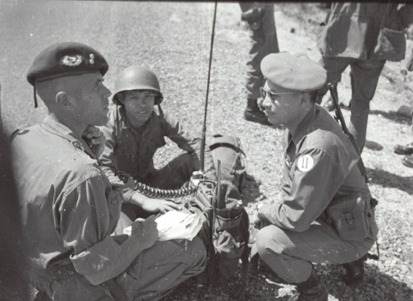 successively eliminate our forces the scheme of maneuver had to make the best use of the factor TIME and to exploit the inherent weaknesses of the enemy troop disposition.
successively eliminate our forces the scheme of maneuver had to make the best use of the factor TIME and to exploit the inherent weaknesses of the enemy troop disposition.
Right in the afternoon 20 October, an Armored Task Force composed of:
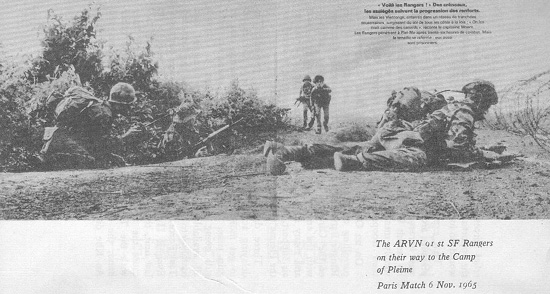
was ordered to move to Phu My, 20 kilometers South of Pleiku. It closed on its assembly area at 1800 hours, bivouacked for the night and impatiently prepared to go on further at dawn.
In the morning 21 October, the Luật Task Force moved on, along the Phu My-Pleime axis but to simply conduct aggressive patrols within a 10 km radius! The order had been expressly given by II Corps Command to the T.F. Commander, Lt Col. Luat, to simulate the imminent approach of a relief column to the Pleime camp while in reality, he had to wait for more adequate and sufficient attachments which would be moved by air from Kontum and Binh Dinh to Pleiku, as soon as the weather conditions allowed the air movements.
In the same morning, at 0930, two companies of the 91st ARVN Special Forces Rangers were heliborne to about 5 km North-East of the Camp. It appeared as if a link-up between the Task Force and these two companies were to take place in the very afternoon! But it was rather an action to meet an emergency situation: the garrison had fought for 36 hours to withstand a five-time-stronger enemy force.
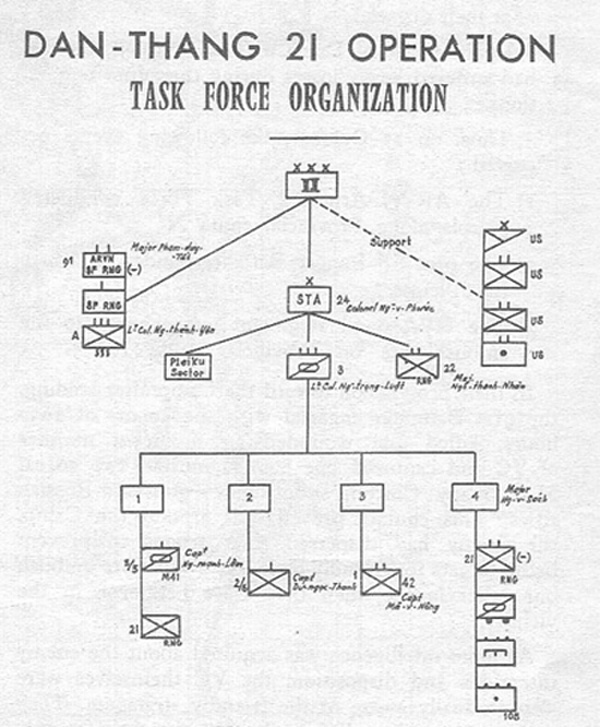
Throughout the second night, the Camp was harassed only by enemy mortars and sustained no attacks.
Convinced that the first part of their plan - to ambush the relief column - was about to take place, the VC Field Front ordered the 32nd Regiment to leave its assembly area1.
It would be interesting to mention that large-scale ambushes by the VC have been in recent past conducted within the frame of the tactics of the war of movement. They no longer exist as static waylays. Such a change in the enemy maneuver of forces is dictated by the following reasons:
In the battle of Duc Co (August 1965), the VC had suffered heavy losses during their first attempts.
Thus, on 21 October, the following events occurred:
In their progression toward the Camp after landing, the 91st Battalion engaged with the enemy at 1030 hours, killed and wounded an unknown number of VC and captured one 82m/m mortar, two 50 cal M.G., many Chicom submachine-guns and Russian rifles. This contact proved that around the Camp, the enemy had dispersed their troops to prevent being targets for friendly airstrikes and also to ambush our relief forces when they were heliborne in the vicinity.
As more intelligence was acquired about the enemy intentions and disposition, the VC themselves were also gradually aware of the friendly stratagem. They soon discover that all friendly activities thus far only aimed at alluring them to wait for the attack of the relief forces. If they hurried to destroy the camp, the opportunity, which they had longed for impatiently, would no longer take place.
That explained why during the third night, their pressure around the Camp was increased. The Camp was harassed by fire throughout the night but still no assault was conducted. By such action the enemy simply meant that unless relief forces were sent in, their troops would remain and tighten their hold.
On 22 October, the Armored Task Force kept on patrolling on the same itinerary and the 91st SF Ranger Battalion continued to advance in the direction of the Camp. The latter made two more contacts with the enemy and captured 4 heavy machine guns and many rifles. In the afternoon, with a strong air support, it came finally to destination to reinforce the Pleime Camp.
Three days and three nights had passed. The delaying activities had enabled II Corps Command to get more information about the enemy and to gain time. The "Than Phong 6" Operations were still going on (until 24 Oct), and on 22 October all available aircrafts were used to transport one battalion to reinforce Quang Duc. Besides the Armored Task Force, only remained at Pleiku a Ranger Battalion. Even if II Corps Command decided to engage its last unit, there would be no aircrafts at disposal because the 119th Helicopter battalion was still busy with the Than Phong 6 Operations. On the other hand, the foggy weather over the Mang pass and An Khe did not allow any air moves to take place.
During the fourth night, the reinforcement by the 91st battalion had somewhat reassured the garrison. But it was by this time that difficulties arose. For four days the V.C. dense fire-power had prevented the Camp to get their supply of water at a stream in the vicinity. In addition to that critical shortage, the main radio antenna was broken by enemy fire at 0510 hours.
Ambush and Counter-ambush
Early in the morning 23 October, as soon as report from the Camp reached II Corps Command, decision was immediately taken to push the relief column to Pleime without delay and at any costs.
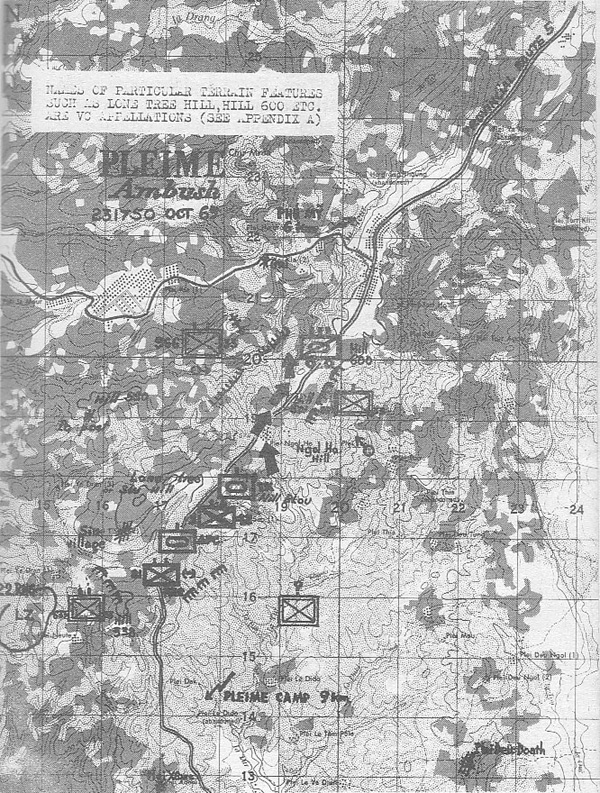
At 1000 hours, the 1/42 ARVN battalion was air lifted from Kontum to Pleiku, conveyed to Phu My upon arrival and attached to the Armored Task Force. The 22nd ARVN Ranger battalion - the last unit to remain in Pleiku - was ordered to standby for a helilift at 1400 hours. The strength of all the above outfits, including the Armored Task Force amounts to about 1000 troops. It was still inferior to an enemy force of regimental size well entrenched in their ambush positions but the fact is that there did not remain any other ARVN fighting units in Pleiku. To meet all contingencies, II Corps Command requested US Task Force Alpha (Major General Stanley R. Larsen, HQS Nha Trang) to temporarily assume the security of the Pleiku Airfield and Pleiku city and at 1300 hours, Task Force Ingram composed of one infantry battalion and one battery belonging to the 1st US air Cavalry Division came as scheduled.
At 1400 hours, the 22nd ARVN Ranger battalion was heliborne into a landing zone on the Western side of Provincial route #5, 10 km North of Pleime, with the mission to:
At the same hour, the Armor-Infantry Task Force departed from Phu My and attacked along the provincial route #5 axis to relieve the Camp of Pleime.
At 1700 hours, the Task Force stopped midway while preplanned airstrikes were conducted ahead over suspected enemy concentrations.
At 1750 hours, while progressing on an ascending slope and narrow path with dense vegetations on both sides, the TF suddenly encountered violent fire from the South and East. Simultaneously, the enemy assaulted the rear of the column which included the combat trains.
The terrain was completely favorable to the enemy and their heavy fire carefully distributed. But the quick reaction of friendly troops, amply supported by the guns and machine guns of the tanks and the APC's as well as the almost instantaneous intervention of the Air Force, all had contributed to make an effective barrage against the successive waves of enemy attacks. Sporadic fire lasted until darkness fell over the battlefield. The Task Force rapidly reorganized its positions because the enemy would certainly resume their activities at night. They did as expected at 0315 hours but did not succeed in making any penetration into the friendly positions. As in the afternoon, the Air Force once again gave an outstanding show of effective and accurate fire.
In the morning 24 October, while resupply and medical evacuation were carried out, patrols were sent out by the TF around the battlefield. 120 VC dead bodies remained on the ground, 75 crew-served and individual weapons were captured with some prisoners. In the diary of a VC named Nguyen dinh Can, - a remnant of the battle in question - who was captured later in the second phase, the following lines have been written in souvenir of the 23 October:
"We are lying along the side of the road, waiting to open fire. When order is given, all our weapons compete one another to make noise. The enemy gets mad. Their guns in the tanks incessantly spit fire against us and their aircrafts from all directions strafe all over the battlefield. A comrade who was born in the same place as mine dies while performing his job as litter-bearer. Another comrade who has been wounded at his arms also dies. It is indeed difficult to compute how large the enemy fire volume is. Alas, why does the enemy have so many aircrafts and why is their barrage so dense? Oh! the Napalm bombs! It seems as if a steel-net were surrounding me!"
Throughout 24 October, the situation remained completely quiet. Even so, Task Force Ingram(2) had moved from Pleiku Airfield to position at 10 km South of Phu My in order to provide artillery fire support to the Armor-Infantry Task Force when necessary. The VC failure in carrying out the first part of their plan also doomed their tentative to destroy the Camp of Pleime. The 32nd Regiment was ordered to withdraw instead of joining the 33rd Regiment which was surrounding the Camp. The Camp sustained only some enemy mortar shelling at 0150 hours that night.
At 1300 hours 25 October, the Armor-Infantry Task Force resumed advancing toward Pleime. After 5 km, the APC's moving ahead of the column encountered enemy fire which was quickly repressed by friendly artillery. The TF arrived at Pleime at dusk.
A sweep of the surroundings of the Camp was immediately conducted in the morning 26 October. Elephant grass was all over around. At 1015 hours, while the TF was deploying South of the Camp, a violent enemy fire suddenly broke out. By fear of being run over by the heavy tanks and APC's, the VC had striven to get the upper hand by an improvised ambush but unfortunately, they were in a too disadvantageous position, concealed but not covered against the intense combined fire from the Armored vehicles, the Artillery and the Air Force. When the skirmish was over, other 140 VC lay dead on the ground, 5 were captured and at least 100 others wounded, with more than 20 crew-served weapons.
The sweep lasted until noon 27 October. Down south the Camp, in the vicinity of the famous hill of Chu-Ho, more enemy corpses and weapons were discovered. Some dead VC gunners were found chained to their anti-aircraft heavy machine guns.
The Task force was ordered to leave Pleime and return to Pleiku on 28 October, as no enemy presence was registered and the surroundings of the Camp thoroughly swept. To secure Provincial route #5 for the withdrawal of the TF, the Vietnamese Marine Alpha Task Force had been air-lifted from Banme-thuot and on their way back, the Armor-Infantry TF encountered no opposition but 6 anti-tank mines which were recovered.
The Dan Thang 21 Operations so ended with about 400 casualties on the enemy side. But the threat from an enemy reprisal still hung over the Camp of Pleime as long as the remnants of the 32d and 33d NVA Regiments were not pursued. This consideration has let II Corps Command to take a decision which will be presented in the following chapter.
(1) See Documents:
(2) Reinforced with one more battery. The 1st Brigade of the 1st US Air Cavalry Division was moved to the Pleiku Airfield at 2400 hours 24 October, right after the Operations in Vinh Thanh valley (Binh Dinh) were over.
Major General Vinh Loc
Colonel Hieu, ghostwriter
(Why Pleime - April 1966)
- A Few Things You Should Know about Pleime-Iadrang Campaign
- "Victory at Pleime" ?
- Tactical Moves in Pleime Battle
- The Two Principals Players Of Pleime Chess Game
- Pleime Battle's Diary
- Why Pleime
- Battle of Pleime
- Plei Me Battle
- 1st US Cavalry Division Gives Support in the Battle at Plei Me
- Seven Days of Zap
- Pleime Campaign
- Battle of Duc Co
- American Perspective of Pleime Battle
- The Truth about the Pleime Battle
- Crushing the American Troops in Central Highlands
- Crushing the American Troops in Western Highlands or in Danang?
- NVA 66th Regiment in Pleime-Ia Drang Campaign
- The Fog of War: The Vietnamese View of the Ia Drang Battle
- What Really Happened at Ia Drang Battle
- The Political Commissar at the First Battle Against the Americans in Central Highlands
- The Unfolding of Strategic and Tactical Moves of Pleime Campaign
- Reviewing "Why Pleime"
- CIDG in Camp Defense (Plei Me)
- Things the VC Don't Want People To Know at Pleime Battle
- Pleime Through New York Times' View
- Ia Drang Valley Battle? Which One?
- General Schwarzkopf's Naďveté In Ia Drang Battle
- LZ X-Ray After Action Report - LTC Hal Moore and Colonel Hieu
- NVA Colonel Ha Vi Tung at Pleime-LZ Xray-LZ Albany
- Pleime Battle Viewed From G3/I Field Force Vietnam
- Than Phong 7 Operation Viewed From G3/I Field Force Vietnam
- Pleiku Campaign
- Pleime Campaign and Pleiku Campaign